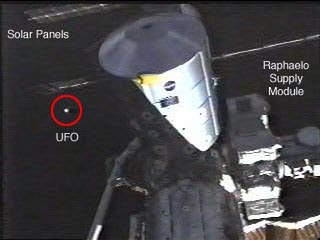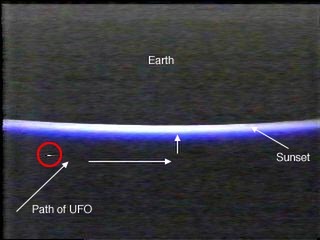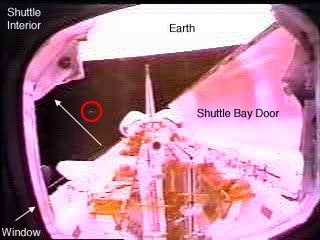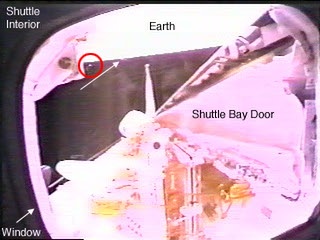- Comment
-
- From Jack Jones
3-19-2
-
- Jeff,
-
- The new shuttle video clips are great. I love seeing
proof of UFO's and find all but the last clip to be very compelling. However,
the last clip doesn't live up to it's hype of undeniable proof.
-
- If you watch the clip frame by frame you can see some
very interesting features. Watch the video again and see if this interpretation
makes any sense:
-
- The clip begins with the camera zoomed into the sunset.
You can tell the camera is zoomed by the height of the sunset. Throughout
the clip the height of the sunset get's smaller then larger, etc. depending
on the camera's zoom. Soon after the clip starts the camera changes it's
zoom, it "zooms out", you can tell by the shorter height of the
sunset. Another consequence of "zooming out" is that the camera
sees a bigger field of view, i.e. more stuff will be visible in the camera.
As the camera zooms out Venus, or the Moon, or Sirius, or a bright artificial
satellite, or an alien ship, I don't just some bright object comes into
the field of view. When the camera finishes zooming out the UFO comes to
a stop.
-
- Next the UFO moves very nicely to the middle of the frame
for us. I submit that the camera operator is simply panning the camera
to the left to center the object in the camera's view. It's much easier
to tell that the camera is panning when we have a point of reference like
the shuttle bay. However in the clip we really don't have a good point
of reference due to the darkness and lack of an object like the shuttle
bay.
-
- The next event is that the camera zooms in on the object
and the sunset. Once again you can see this by watching the sunset's height
grow as the camera zooms in. Then we watch as, due to the motion of the
shuttle orbiting the earth, the object disappears behind the earth. One
interesting note here, you should be able to see that we are seeing the
object through the earth's atmosphere. Such a large amount of atmosphere
causes any light to appear to twinkle. Astronomer's know this twinkling
very well. They must deal with the atmosphere every night.
-
- Thank you very much for you web site and your radio program.
You provide an invaluable service to the world. You have certainly woken
me up.
-
- -Jack Jones
Jack -- interesting analysis -- except for one factor. If the camera
zoomed out, the further edges of the earth, considerably more curved than
we see consistently throughout the clip, would appear on either side and
the image of the earth would shrink slightly in the frame. This doesn't
happen. Not even slightly. A pan to the right, as you suggest, to cause
the object in question to appear to move to the right into the center,
would likewise give us a strong shot of the increasing curve of the earth,
especially for the amount of movement we see in the object. That doesn't
happen either. When the object first appears, it moves into the frame at
an angle and stops. At no time does the crest of the sunlight across the
earth change to reflect this movement. I believe the increase and decrease
of light intensity (which happens a few times) from the setting sun across
the earth is an iris change, not a zoom. Also, I wish you could see the
full video sequence, but it would be too massive of a file. There are earlier
zooms, and the curve of the earth fits the screen image very differently.
What we have here is a consistent image of the curve of the earth, with
the light diminishing. - Webmaster
-
-
-
- Comment
(name witheld by request)
3-19-2
-
- I just looked at the videos on your web site about NASA's
Dirty little secret, I'm hoping that something got lost in the translation.
Because these are very unconvincing.
-
- I used to work at NASA as a computer tech (See enclosed
ID Badge) and so I've seen a ton of cool things, but these videos just
look like stuff floating around.
-
- Lets start with the "blinker" Clip 4. I would
bet every penny I own that the BLINKER is attached to something, there
is even some artifacting from the UFO to the cross member above. So this
in my opinion is nothing to get excited about.
-
- Clips 1 through 3, Space junk, no changes in speed or
angle or direction. JUNK floating through space.
-
- Clip 5 - This IS an interesting clip, my first instinct
when saw it was the camera man sees something in space and centers it and
then the shuttle moves away. The cool thing about compression and QuickTime
is, that you can get some really cool artifacts from it, if you look dead
center of the screen and about 1/3 of the way down, you see this handy
little tear, which doesn't move. Now this could be in the Tape, the lens,
or just something from the computer. If it's on the tape, which I suspect,
then it's nothing. But if it were on the lens or actually out there, then
I would like to know more about it, because it can be a point of reference
then.
-
- Over all the Clips are cute, but nothing ground shaking,
no smoking guns here, I'd almost chalk them up to disinformation to through
us off a scent, but I'm sure the person who submitted them was in earnest.
-
- Well, that's just my two cents worth. Please if you use
any of this letter, please don't publish my NASA badge. I sent it to you
just as proof.
-
- Love the show and the site.
-
- Take Care,
- Ron
-
-
- Ron,
-
- Thanks for your comments. One of the clips which I could
not digitize because it would have required a massive file size (and even
then the UFO is scarcely visible because of compression) shows the Hubble
being released after repairs. A steadily blinking UFO enters the frame
and the camera operator shifts the camera to remove it from the background.
But the UFO persists and continues to make its appearance in the frame,
and the camera operator frantically zooms and pans and bumps the camera
around trying to avoid it, even to the point of having an awkwardly off-center
shot of the Hubble drifting away. He finally gives up as the UFO passes
on the other side of the Hubble where he can't avoid it and after a few
seconds of this unavoidable taping, the transmission goes completely static
and back to Houston control, with no commentary.
-
- The "space junk" theory has been around for
some time. I've seen video footage of what looks like twinkling particulate
matter in space. Its very random in size, rate of twinkle, direction of
movement, etc. One thing that puzzles me is, why does THIS type of space
junk we're seeing again and again fly by so fast, and other times so slow,
and yet both kinds blink on and off (not merely twinkle; its a steady pulse);
and why is this space junk so bright and wouldn't it be awfully large junk?
And why doesn't this "junk" pose the threat to the delicate elements
of satellites (like solar panels) or the cargo bay of the shuttle, why
isn't it slamming into the shuttle (some at tremendous speed, it seems)
and causing problems if there's that much out there?
-
- As regarding Clip 4 -- my question would be, why did
NASA edit out this blinker in its replay of highlights that day? Doesn't
make sense. I agree, compression leaves behind a lot of artifacts, unfortunately,
but having viewed the original videos, there's no apparent attachment to
the Raphaelo module or ISS and -- again -- NASA deliberately edited the
object out on rebroadcast.
-
- Any panning or zooming in Clip5 would change the shape
of the earth rim in the image. It remains consistent, apart from the fading
light as the shuttle moves away, throughout. The first part of the video,
not in the clip because of file size, is the camera operator taking a lot
of time to get the shot set up and centered. Once he does, it's a good
5 minutes of steady shooting, as the shuttle moves and the sun sets...
details on the earths surface diminish as the light diminishes. At no time
does the shape of the earth crescent change at either side, which would
happen if he zoomed in or out, or panned. - webmaster
-
-
-
- Comment
-
- From Umar
umar.shamsi@ni.com
3-22-2
-
- Hi.
-
- Dr. Swearingen, Thank you very much for the tape...
I was surprised to receive it so quickly...
-
- I forwarded it to the most impressive section (the sunset
sequence)... And after viewing it a few times, I think I have an explanation
of sorts... I believe the zooming in from the bottom left, then standing
still was the camera zooming out... the horizontal motion to the right
was the camera panning left... the motion downwards was the camera zooming
in a little bit... and at all points you can see the object slowly receeding
to the horizon.
-
- I base this on the the fact that during the initial zooming
up and to the right motion, the point where the horizon meets the edge
of my TV screen (36 inches) goes up a few picture elements.
-
- I don't think I looked carefully at the second vertical
motion, but it was much smaller than the first, so the horizon track on
the edge would be less noticeable.
-
- I still think it's a little strange that the object would
receed as quickly as it did, and remain as bright as it did al the way
through... It seems as though either it was just still (relative to the
earths center), or orbiting in the reverse direction from the shuttle...
either of which seems strange.
-
- Anyways... just my thoughts...
-
- -Umar.
|




